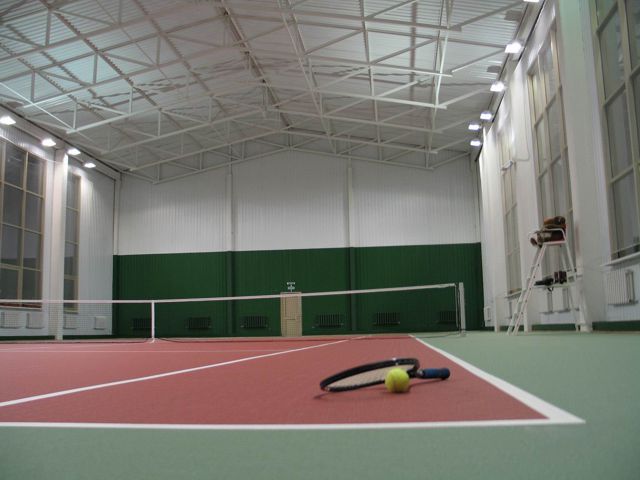ILLUMINATION OF TENNIS COURTS
Play tennis on court - a rectangular platform with an equal surface and the put marking.
In the middle of court the grid which passes on all width, parallel to back lines is tense, and divides court into two equal half.
Length of court - 23,77 m, width - 8,23 m or 10,97 m for pair game.
Lines along the short parties of court are called as back lines, along the long parties - sidelines.
When rationing characteristics of lighting the court is a direct playground.
Behind borders of a marking the additional space for movement of players is provided.
The platform together with additional space is called "a cumulative game field".
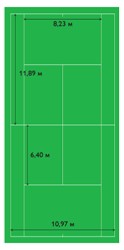
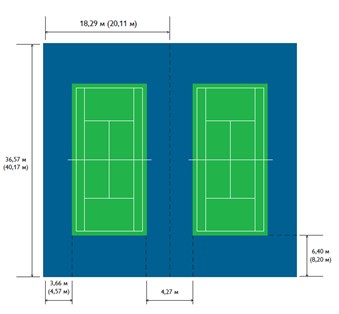
Minimum admissible distance between a sideline of court and any rigid design has to make not less than 3,66 m.
For safety of players courts it is impossible to dispose "a back to a back" if they aren't divided by special partitions.
One more important parameter is the hall height which in turn determines height of installation of lamps. By rules of the ATP tournaments (Association of tennis players - professionals) the minimum height of a ceiling has to make 12,19 m.
When rationing characteristics of lighting the court is a direct playground.
Behind borders of a marking the additional space for movement of players is provided.
The platform together with additional space is called "a cumulative game field".
REQUIREMENTS TO ILLUMINATION OF THE COURTS PLACED IN HALLS
The tennis ball moves with very high speed. When giving by the high-class player the ball can gather speed to 200 km/h.
In this regard it is very important to provide to players the best visibility of a ball. From here raised requirements to quantitative and qualitative characteristics of lighting: there shouldn't be sharp shadows, the blinding operation of light devices has to be minimized, and contrast of a ball against a platform and a surrounding background has to be greatest possible. Also there shouldn't be a sharp change of levels of illumination behind borders of directly game field.
Levels of illumination depend on a game class, and also on, whether there is a court in a hall or in the open air. The international federation of tennis (ITF) accepted the classification of competitions offered in the European standard on sports lighting (EN 12193):
Class I: national and international competitions of high level;
Class II: competitions of the average level: regional or club, including trainings of tennis players of masters;
Class III: competitions of initial level, training occupations of sports schools and occupation for rest.
|
|
Е, Lx
|
GR
|
Ra
|
T, K
|
|
Class I
minutes
|
1000
750
|
≤ 50
|
65-80
≥ 60
|
> 4000
|
|
Class II
minutes
|
750
500
|
≤ 50
|
65-80
≥ 60
|
> 4000
|
|
Class III
minutes
|
500
300
|
≤ 55
|
65-80
≥ 20
|
> 4000
|
Lighting design, as a rule is reduced to a choice of height of support and placement of searchlights concerning a platform.
At illumination of single court the minimum height of a support makes 6 meters, and recommended 8-10 meters.
For illumination of the covered tennis courts it is best of all to use LED searchlights for sports lighting which are characterized:
high efficiency (> 80 Lm/W),
stable light characteristics (recession of a light stream by the end of service life doesn't exceed 10%),
high colors the rendering characteristics (Ra> 80),
long service life (> 50 000 hours).
LIGHTING MODELLING, CALCULATION
At lighting modeling and calculation requirements for illumination of the closed tennis courts were considered.
Problem definition:
Illumination E=500 Lx,
Indicator of the blinding action, GR ≤ 50,
Color rendering index ≥ 60,
Color temperature, K > 4 000
The received results of lighting calculation are given in illustrations:
Fictitious colors:

Calculation Grid (grayscale / graph values E):
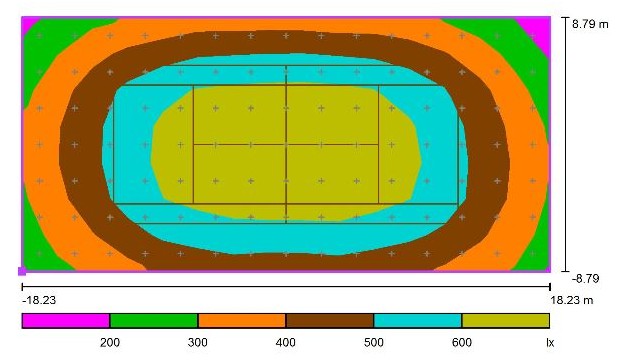
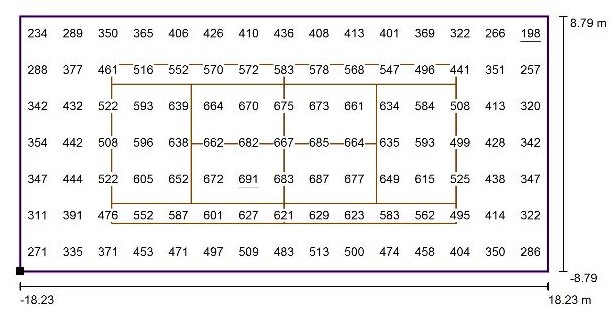
For implementation of the project on lighting of the tennis hall we suggest to use a searchlight of sports illumination of SATURN - 200W.
Finally
